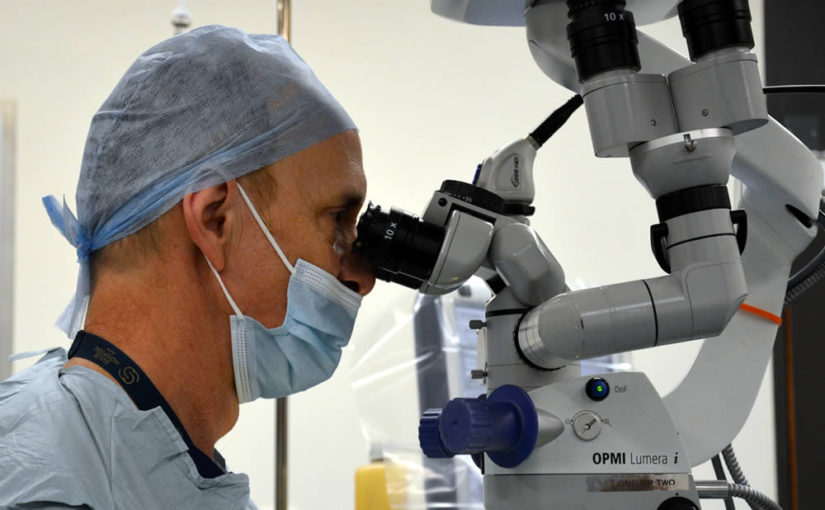What to expect on the day of injection
On the day of the injection, I will clean up around your eye with some antiseptic and put some antiseptic and anaesthetic drops in your eye. I then place a spring called a speculum on your eyelids to keep them open. I will ask you to look over to 1 side and measure where I will place the injection.
The injection takes only a few seconds and you may feel a mild prick as the needle goes in, similar to a blood test. You may notice some floaters in the centre of your vision like little flies. These take 2 to 3 days to clear. Afterwards I will give you some lubricating drops to put into your eye 3 times a day for 3 days.
How many injections will I need?
The original trials for Lucentis involved having an injection every 4 weeks for 2 years (24 injections). Analysis of the results showed that any improvement occurred over the first 3 months and subsequent treatment is aimed at keeping eyesight at the stabilised level.
There are 2 main ways this is done, PRN and Treat and Extend. PRN dosing means having an assessment every month and if there is activity then having an injection. Treat and extend dosing means having an injection at every visit but trying to make the time between each injection longer if there isn’t significant activity.
In general PRN means more visits but fewer injections, whereas Treat and Extend means fewer visits but more injections. PRN treatment reduced the average number of injections down to 13 to 14 over 2 years with similar results.
“I have been attending the retina clinic for the last 2½ years. Hopefully my next visit will be my last as I have not had an intravitreal injection for over a year. I wanted to express my sincere thanks for the wonderful service I have always had. The information and reports on my condition (macular degeneration) have always been extremely efficient and informative.” Mrs W, Bath
Risks of the procedure
The main risk for an injection into the eye is infection inside the eye (called endophthalmitis). Data from the drug trials with Lucentis would suggest that this is in the order of 0.1% i.e. 1 in every 1000 injections. Experience outside the clinical trials have suggested this is much less common, occurring after about 1 in 15000 injections.
There are other theoretical risks including retinal detachment, cataract and rise in intraocular pressure. It is also possible to be allergic to any drug.
Risks of Anti-Vascular Endothelial Growth Factor Agents
There are theoretical risks from Anti-Vascular Endothelial Growth Factor drugs of ‘thrombo-embolic’ events, which means heart attacks or strokes. In the large trials carried out with Lucentis, there were no more strokes or heart attacks in patients having the injection than in those who didn’t have the injection.
When Avastin is given in large doses as chemotherapy for colorectal cancer, there are some of these side effects. It is not known however if they still occur with the tiny doses used for injecting into the eye. The American CATT trial did not show any increased risk of thrombo-embolic events with Avastin compared to Lucentis.
One unexpected result from the CATT trial was that patients were more likely to be admitted to hospital after Avastin, but for many different conditions such as chest infections or urinary tract infections. It is not known whether this was caused by the Avastin or just occurred by chance.
Risks of intravitreal steroid
With intravitreal triamcinolone injections there are two main specific risks; cataract and raised intraocular pressure. Cataract formation occurs in a large proportion of patients who have not already had cataract surgery.
Raised pressure inside the eye occurs in most patients to some degree, and in a small proportion of patients the pressure can be so high to require treatment usually with drops. Rarely patients can require glaucoma surgery.
The Ozurdex implant uses a different form of steroid: dexamethasone. This has been shown to have a much lower rate of cataract formation and raised pressure.
